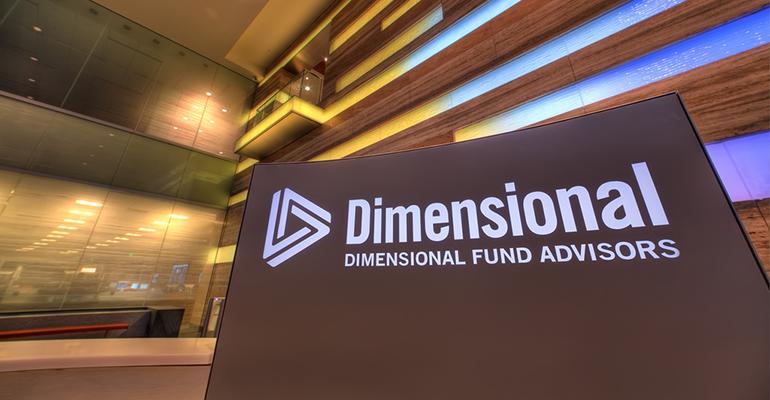(Bloomberg) -- Dimensional Fund Advisors just became one of the biggest players in the $6.5 trillion exchange-traded fund arena.
In a milestone moment for the money management industry, the $637 billion quant pioneer founded by David Booth has converted four equity mutual funds with $28.8 billion of assets into ETFs.
At a stroke, it puts Dimensional on the cusp of being one of the 10 biggest U.S. ETF issuers by assets and takes its lineup to seven funds.
Meanwhile the Austin, Texas-based firm has already filed for at least two more conversions. It is also looking at fixed-income products and hopes to launch a solution in that space by the end of the year, according to co-Chief Executive Officer Gerard O’Reilly.
It’s a seismic shift for Dimensional, which has long eschewed ETFs in favor of its gated mutual funds. But the industry trend has been toward the easier-to-trade, often more tax-efficient vehicles for years, and rule changes in late 2019 paved the way for a host of major holdouts to branch out into ETFs.
“We’re wrapper agnostic,” O’Reilly said in an interview. “As long as we can do what we need to do in each wrapper.”
The names of the ETFs are:
- The Dimensional U.S. Equity ETF (ticker DFUS, formerly the Tax-Managed U.S. Equity Portfolio)
- The Dimensional U.S. Small Cap ETF (DFAS, formerly the Tax-Managed U.S. Small Cap Portfolio)
- The Dimensional U.S. Targeted Value ETF (DFAT, formerly the Tax-Managed U.S. Targeted Value Portfolio)
- The Dimensional U.S. Core Equity 2 ETF (DFAC, formerly the T.A. U.S. Core Equity 2 Portfolio)
Only a handful of trades had taken place in the ETFs as of 10:05 a.m. in New York.
One of the key factors for Dimensional was capturing the tax advantages, O’Reilly said. Money entering or leaving an ETF goes via a market maker, who then swaps some of the fund’s underlying assets for new shares or vice versa. This “in-kind” transaction means a taxable sale hasn’t taken place.
Since Dimensional first unveiled its conversion plans in November, the focus on taxes has only sharpened. The Biden administration’s budget proposes nearly doubling the capital gains levy for households earning more than $1 million.
“Taxes are a very important consideration for investors right now because there is some uncertainty about what the overall tax picture will be in the future,” O’Reilly said. “When we add the ability to manage capital gains through in-kind creations and redemptions, we think it will be an additional tool that will be more efficient going forward.”
Big Entrance
With competitive pricing and its famous name, Dimensional has quickly carved out a foothold in the ETF universe just a year after announcing plans to enter the industry. It launched a trio of actively managed equity ETFs in November and December that have already accumulated nearly $1.6 billion in assets.
The quant giant’s conversions are arguably more important, however. It’s the first major player to undertake the move, after Guinness Atkinson Asset Management executed the successful switch of two mutual funds with about $30 million between them in March.
In a recent report, Citigroup Inc. analysts wrote that Dimensional’s conversions will provide a benchmark of sorts for other issuers. Alongside the growth of actively managed ETF strategies, it could ultimately push most of the $21 trillion mutual fund universe toward ETFs within the next decade, they said.
According to O’Reilly, however, Dimensional has no plans to become an ETF-only shop. For all the advantages of an ETF, the U.S. retirement system and 401(k)s are largely designed to integrate mutual funds.
As such, the systematic pioneer is looking to build out its ETF lineup alongside its mutual funds and separately managed account offerings, he said.





